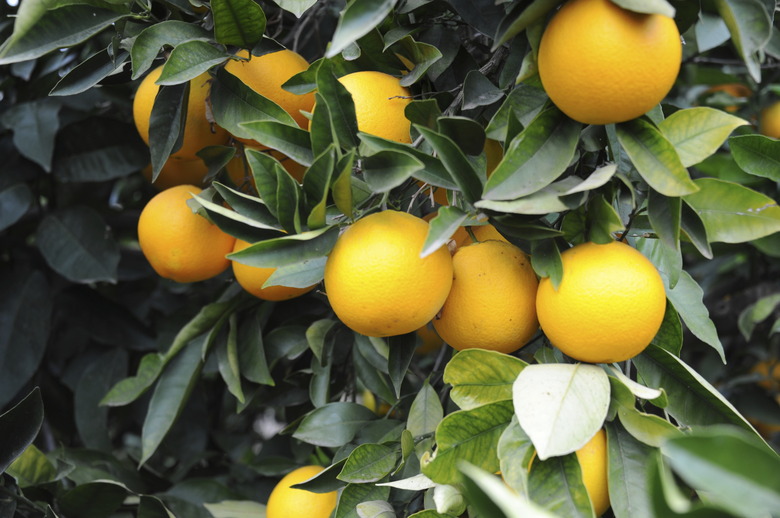Orange Trees In Georgia
The best chance of growing sweet orange (Citrus sinensis) outdoors in Georgia is in coastal Georgia, which falls in U.S. Department of Agriculture plant hardiness zone 9a. In the rest of Georgia, USDA zones go from 6a in the north to 8b in southern Georgia. Sweet orange is generally hardy in USDA zones 9 through 11, though some cultivars differ in hardiness. In USDA zone 8, select a cultivar suited to this cooler climate or try outdoor growing by finding the warmest microclimate and covering the tree in winter when needed.
Step 1
Cultivars recommended by the University of Georgia Extension include the juice orange **"Hamlin,"** hardy in USDA zones 8b through 10. For fresh eating, the **navel orange varieties "Dream," "Washington" and "Summerfield"** provide seedless fruits ripening from October to December; these are hardy in USDA zones 9 through 11. A hybrid sweet orange released in 1989 is also a possibility for Georgia. Called **"Ambersweet"** orange, the tree is hardy in USDA zones 8a through 10.
Planting Site
Step 1
Even in coastal Georgia, give sweet orange the warmest locality possible, such as on the south side of a building or wall. This also protects the tree from prevailing north to northwest winter winds. Avoid locating the tree near drain fields or septic tanks. The best time to plant an orange tree is in spring after all danger of frost is over.
Step 2
- Cultivars recommended by the University of Georgia Extension include the juice orange **"Hamlin,"** hardy in USDA zones 8b through 10.
- For fresh eating, the **navel orange varieties "Dream," "Washington" and "Summerfield"** provide seedless fruits ripening from October to December; these are hardy in USDA zones 9 through 11.
Soil and Light
Step 1
Sweet orange tolerates different soil types as long as they're well-draining. Trees grow best in full sunlight, but the University of Georgia Extension suggests locating oranges under live oaks or pines. You'll get fewer fruit but the branches of the taller tree gives added frost protection by trapping warm air beneath the canopy.
Water Needs
Step 1
Water citrus trees thoroughly and deeply, allowing the surface 2 inches of soil to dry between waterings. Younger trees with shallower root systems need more frequent watering than more established trees that have been planted for five years or more. In areas that receive 40 to 45 inches of annual rain, this is usually sufficient for orange trees. Central Georgia averages between 45 and 50 inches of rain yearly, while the city of Brunswick, on the coast, receives 45 inches of rain annually.
Step 2
- Sweet orange tolerates different soil types as long as they're well-draining.
- In areas that receive 40 to 45 inches of annual rain, this is usually sufficient for orange trees.
Fertilizing Young Trees
Step 1
Regular fertilizing is important to orange tree establishment. During the first three years a tree's in the ground, the University of Georgia Extension suggests using 8-8-8 fertilizer with micronutrients four times a year. For the first year, apply 1/3 pound on March 1, 1/2 pound sometime during April 15 to 30, 2/3 pound between June 1 to 15 and 1 pound between July 15 to 30. Second-year trees should receive 1, 1 1/4, 1 1/2 and 1 3/4 pounds at the same spacing, and 3-year-old trees need 1 3/4, 2, 2 1/2 and 3 cups each of those times.
Fertilizing Established Trees
Step 1
For mature trees, apply about 1/2 pound of the 8-8-8 fertilizer for every year of the tree's age, repeating applications three times a year, in February, May or June and August or September. Scatter the fertilizer under the tree branches, keeping it away from the trunk and taking it about 6 inches beyond the branch ends. Water it in.
Step 2
- Regular fertilizing is important to orange tree establishment.
- For mature trees, apply about 1/2 pound of the 8-8-8 fertilizer for every year of the tree's age, repeating applications three times a year, in February, May or June and August or September.
Winter Protection
Step 1
Especially for the critical first three years of the young sweet orange tree's life, have winter protection on hand for below freezing weather. Young trees can't withstand cold as well as mature trees. Use frost blankets for light freezes and heavier blankets for more severe cold. For young trees, put up a pop-up greenhouse over the tree. Hold the covering material off the tree itself with a framework of pipes or wood. For extra protection, put one or two light bulbs under the cover. To make sure you don't lose the tree in severe cold, wrap the trunk with an insulated fiberglass or foam rubber wrapping material that's at least 6 inches thick. Plan on covering the orange tree anytime during its life that cold weather threatens.
Step 2
- Especially for the critical first three years of the young sweet orange tree's life, have winter protection on hand for below freezing weather.
- To make sure you don't lose the tree in severe cold, wrap the trunk with an insulated fiberglass or foam rubber wrapping material that's at least 6 inches thick.
References
- U.S. Department of Agriculture: Plant Hardiness Zone Map
- Floridata: Citrus Sinensis
- Southern Fruit & Vegetable Gardening; Katie Elzer-Peters
- University of Georgia Extension: Citrus Fruit for Southern and Coastal Georgia
- Citrus Pages: Sweet Orange
- NOAA National Weather Service: What's Typical in North and Central Georgia
- U.S. Climate Data: Georgia: Brunswick
- University of Georgia Center for Urban Agriculture: Care of Citrus Plants in Georgia
